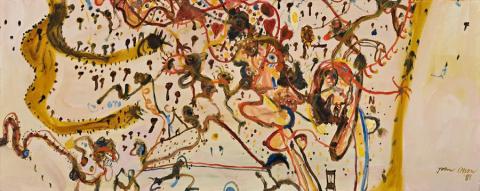CLARENDON LANDSCAPE WITH MUSE, 1981
John Olsen
oil on canvas
73.0 x 181.0 cm
signed and dated lower right: John Olsen / 81
Australian Art Resources, Melbourne
Private collection, Melbourne
John Olsen's move to Clarendon in July 1981 introduced a halcyon period in his life and art. The hamlet, set in a beautiful countryside of surrounding hills, was close enough to Adelaide for easy travel, yet far enough away to live the country life free of the urban frenzy. It was also a time of artistic excitement and achievement in South Australia when the patronage of an enlightened government saw great advances in the ‘Athens of the South’. Olsen had acquired ‘The Old Rectory’, a colonial stone manse, with the nearby studio in the historic old Institute Building. His daily routine often began and ended in contact with the village life as he walked to and from his studio. There was also the poetic muse, his ongoing love of poetry, especially that of Dylan Thomas whose unforgettable characters and imaginary Welsh village life in Under Milk Wood had a seemingly intuitive affinity with that of Clarendon. Olsen observed:
This will mark a new period in my life and work. Our house is like an eagle's nest perched over the village… opposite is a particularly steep hill that has sheep climbing up it, clusters of crows flying up and down, cockatoos white and splendid soaring past, clouds seem on eye level, & sheep tracks make fascinating meanders over the hill's surface.1
This euphoric sense of renewal spills over into his paintings of the time, especially in the animated land and mood scape Clarendon Landscape with Muse, 1981. The characteristic aerial view delineates a map of place and experience. Here the expressionist lines of paint capture the winding roads across the hills, the dip and vale, the church with its cross on its steep roof, animals, figures, faces, and even a chair. There is also an egg; that fond metaphor of regeneration and fertility that found its way into many an Olsen painting, wedding the celebratory bon viveur with the sun-baked Australian landscape. A more gustatory classic of this time is Duck àl’Orange, 1981 (formerly The Christensen Fund), while the lyrical Golden Summer, Clarendon, 1983, in the collection of the Art Gallery of New South Wales, blends land and season in poetic form. His suntanned canvas, A Road to Clarendon: Autumn, 1985, sensuous of form and colour, won the Wynne Prize for landscape that year. It and other paintings inspired by Clarendon represent a golden period in Olsen's art; all touched by Calliope the muse of epic poetry.
1. John Olsen quoted in Hart, D., John Olsen, Craftsman House, Sydney, 1991, p. 152
DAVID THOMAS
